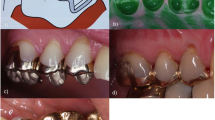Abstract
Cast gold partial crowns (CGPC) are an accepted means of restoring posterior teeth. For aesthetic reasons, gold alloys are being increasingly substituted with ceramics. The aim of the present study was to investigate retrospectively the long-term clinical performance and survival of CGPC and compare the results to the ones already reported for ceramic partial crowns (CPC). The CGPC group consisted of 42 patients (24 male, 18 female) randomly sampled from a total of 106 patients with CGPC, with one restoration per patient. The CPC group consisted of 22 patients with a total of 42 restorations. Both types of restoration were done by one experienced dentist. Another two experienced dentists who were not involved in performing the restorations rated both kinds of partial crowns using the modified United State Public Health Service (USPHS) criteria [14]. The Median age of the CGPC was 57 months (range 3–157) and of the CPC and 63 months (range 24–72). Forty-one (98%) of the CGPC and 27 (64%) of the CPC were placed in molars, the rest in premolars. In each group, 40 (95%) restorations were still functioning without any necessity of replacement. Two teeth with CGPC, in situ for 4.5 and 11 years, respectively, had been extracted for periodontal reasons. Two CPC fractured and had to be replaced after 2 and 6.5 years in situ. The USPHS criteria results were similarly good for the gold and ceramic groups. Kaplan-Meier analysis revealed survival probabilities of 72±21% and 96±4% after 13 and 7 years, respectively, for the CGPC. Survival of the CPC was 81±15% after 7 years. No statistically significant difference among survival functions of CGPC and CPC was found. From this data, it can be concluded that the longevity of CPC is not inferior to that of gold alloys. However, more long-term studies comparing the clinical performance and longevity of these two types of indirect restoration in the posterior region with larger numbers of restorations are desirable.





Similar content being viewed by others
References
Donly KJ, Jensen ME, Triolo P, Chan D (1999) A clinical comparison of resin inlay and onlay posterior restorations and cast-gold restorations at 7 years. Quintess Int 30:163–168
Donovan TE, Winston WL (1993) Conservative indirect restorations for posterior teeth—cast versus bonded ceramic. Dent Clin North Am 37:433–443
Felden A, Schmalz G, Federlin M, Hiller KA (1998) Retrospective clinical investigation and survival analysis on ceramic inlays and partial ceramic crowns: results up to 7 years. Clin Oral Invest 2:161–167
Felden A, Schmalz G, Hiller KA (2000) Retrospective clinical study and survival analysis on partial ceramic crowns: results up to 7 years. Clin Oral Invest 4:199–205
Geurtsen W (1994) Metallische Restaurationen als Amalgam-Alternativen. Dtsch Zahnärztl Z 49:853–858
Kaplan EL, Meier P (1958) Nonparametric estimation from incomplete observations. Am Stat Assoc 53:457–481
Krämer N, Frankenberger M, Pelka M, Petschelt A (1999) IPS Empress inlays and onlays after four years—a clinical study. J Dent 27:325–331
Krejci I, Krejci D, Lutz F (1992) Clinical evaluation of a new pressed glass ceramic inlay material over 1.5 years. Quintess Int 23:181–186
Kreulen CM, Creugers NHJ, Meijering AC (1998) Meta-analysis of anterior veneer restorations in clinical studies. J Dent 26: 345–353
Mörmann WH, Götsch T, Krejci I, Lutz F, Barbakov F (1991) Clinical status of 94 Cerec ceramic inlays after 3 years in situ. In: Mörmann WH (ed) International symposium on computer restorations. The state of the art of the Cerec method. Proceedings. Quintessenz, Berlin, pp 355–363
Pelka M, Schmidt G, Petschelt A (1996) Klinische Qualitätsbeurteilung von gegossenen Metallinlays und -onlays. Dtsch Zahnärztl Z 51:268–272
Reich E (1991) Ergebnisse zur Prävalenz von Parodontopathien. In: Institut der Deutschen Zahnärzte (IDZ). Mundgesundheitszustand und -verhalten in der Bundesrepublik Deutschland. Deutscher Ärzte-Verlag, Cologne
Reinelt C, Pelka M, Krämer N, Petschelt A (1995) Inlays and onlays with IPS Empress—clinical performance after 12 months. J Dent Res 74:938 (abstract 220)
Ryge G (1980) Clinical criteria. Int Dent J 30:347–358
Saxer UP, Mühlemann HR (1975) Motivation und Aufklärung. Schweiz Monatsschr Zahnmed 85:905–919
Schlösser R, Kerschbaum Th, Ahrens FJ, Cramer M (1993) Überlebensrate von Teil- und Vollgusskronen. Dtsch Zahnärztl Z 48:696–698
Stoll R, Sieweke M, Pieper K, Stachniss V, Schulte A (1999) Longevity of cast gold inlays and partial crowns—a retrospective study at a dental school clinic. Clin Oral Invest 3:100–104
Studer S, Lehner C, Brodbeck U, Schärer P (1996) Short-term results of IPS-Empress inlays and onlays. J Prosthod 5:277–287
Studer SP, Wettstein F, Lehner C, Zullo TG, Schärer P (2000) Long-term survival estimates of cast gold inlays and onlays with their analysis of failures. J Oral Rehab 27:461–472
West NX, Addy M, Jackson RJ, Ridge DB (1997) Dentine hypersensitivity and the placebo response. J Clin Periodontol 24:209–215
Author information
Authors and Affiliations
Corresponding author
Rights and permissions
About this article
Cite this article
Wagner, J., Hiller, KA. & Schmalz, G. Long-term clinical performance and longevity of gold alloy vs ceramic partial crowns. Clin Oral Invest 7, 80–85 (2003). https://doi.org/10.1007/s00784-003-0205-8
Received:
Accepted:
Published:
Issue Date:
DOI: https://doi.org/10.1007/s00784-003-0205-8




